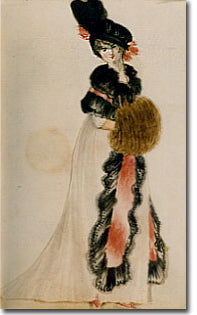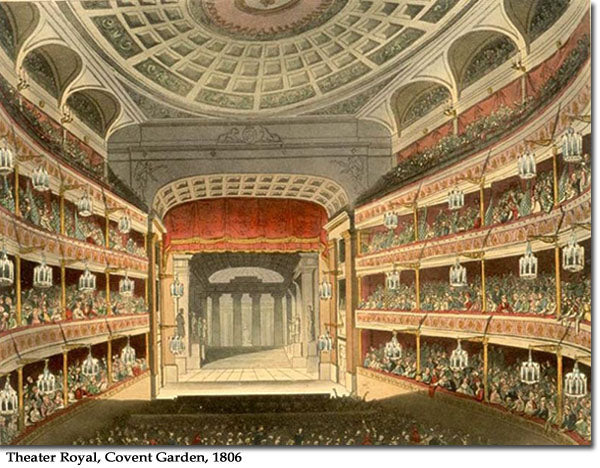Fashionable Ballgowns
"I see what you think of me," said he gravely -- "I shall make but a poor figure in your journal tomorrow." "My journal!" "Yes, I know exactly what you will say: Friday, went to the Lower Rooms; wore my sprigged muslin robe with blue trimmings -- plain black shoes -- appeared to much advantage; but was strangely harassed by a queer, half-witted man, who would make me dance with him, and distressed me by his nonsense." "Indeed I shall say no such thing." "Shall I tell you what you ought to say?" "If you please." "I danced with a very agreeable young man, introduced by Mr King; had a great deal of conversation with him -- seems a most extraordinary genius -- hope I may know more of him. That, madam, is what I wish you to say." Northanger AbbeyIn the minds of many a Regency lass nothing could be more delightful than a ball-- planning for it, dressing for it, dancing at it and, afterward, meeting with friends to talk it all over. In the forefront, therefore, of every girls' mind, must be how best to present oneself, and to this end, the pages of popular fashion magazines would have been indispensable. The following plates track the changing styles in Ballgowns from 1800-1824, a time in which Jane Austen's writing flourished and she too would have been concerned with "the style of sleeves now worn".

 Left: Ball Dress, 1801, from Journal des Dames et des Modes, also called Costume Parisien, 1797-1839. Plate is labeled "An 9." This ball dress is so daring that the lady's left bosom is showing, which may not be visible at this size and resolution. This dress was copied by The Ladies Magazine in their February of 1801 issue (see right figure), but the neckline has been raised. The train is trimmed with two rows of fabric roses, while the darker overdress is fringed.
Right: Ball Dress, February 1801, from The Lady's Magazine, or Entertaining Companion for the Fair Sex, Appropriated Solely to Their Use and Amusement, 1770-1837. This ball dress was copied from a more daring plate in the Paris Journal des Dames (see left figure). The roses trimming the train, the darker overdress with fringe are the same as the Paris plate, but the neckline is much higher.
Left: Ball Dress, 1801, from Journal des Dames et des Modes, also called Costume Parisien, 1797-1839. Plate is labeled "An 9." This ball dress is so daring that the lady's left bosom is showing, which may not be visible at this size and resolution. This dress was copied by The Ladies Magazine in their February of 1801 issue (see right figure), but the neckline has been raised. The train is trimmed with two rows of fabric roses, while the darker overdress is fringed.
Right: Ball Dress, February 1801, from The Lady's Magazine, or Entertaining Companion for the Fair Sex, Appropriated Solely to Their Use and Amusement, 1770-1837. This ball dress was copied from a more daring plate in the Paris Journal des Dames (see left figure). The roses trimming the train, the darker overdress with fringe are the same as the Paris plate, but the neckline is much higher.

It may be possible to do without dancing entirely.Instances have been known of young people passing many, many months successively, without being at any ball of any description, and no material injury accrue either to body or mind; -- but when a beginning is made -- when the felicities of rapid motion have once been, though slightly, felt -- it must be a very heavy set that does not ask for more. -Emma

Originally written for Cathy Decker's Regency Fashion Page. Enjoyed this article? Visit our giftshop and escape to the world of Jane Austen for costume, patterns and more.



Leave a comment
This site is protected by hCaptcha and the hCaptcha Privacy Policy and Terms of Service apply.